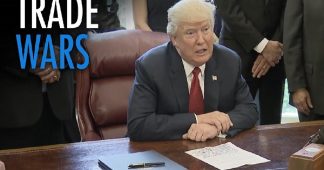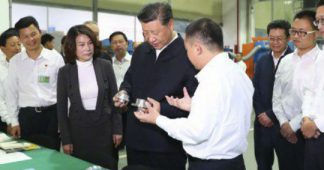April 23, 2020
Seldom a day goes by lately without politicians and pundits from countries all over the world calling for re-establishing their manufacturing base to avoid the vulnerabilities exposed in the wake of COVID-19. Whether it be Canada, Australia, the United Kingdom, or the United States, to cite a few examples, the neoliberal agenda of outsourcing manufacturing abroad in search of lower costs for “cheaper goods” now rings as hollow as the debt-ridden economies of their populations. An “every country for itself” attitude is starting to catch on. If an industrialized country can’t supply itself in an emergency, is it truly industrialized? National security dimensions of economic planning that have receded and were dormant for decades are back in play.
But the process of moving essential supplies back (or closer) to home is easier said than done: Reassessing capacity-planning strategies on the grounds of national security, redomiciling supply lines or reviving homegrown industry all entail significant geopolitical ruptures with the patterns that have formed for the past 50 years. The process requires a fusion of old ideas projected into new technological capacities, like automation and quantum computing, and a design that promotes a continuum of stability and cooperation from the old order. And while every nation will certainly think of itself first, it would be suicidal not to think outside of one’s borders, starting with regionalization. It’s easy to realize that wider common human welfare must be incorporated in the planning for the future, as so many of our challenges, from public health to the environment, are of a planetary scale. But there is also an element of Voltaire’s dictum of tending to one’s own garden that must come into play as well. The World Trade Organization (WTO) and other multilateral entities must accommodate both realities or go the way of the dustbin.
So where is a nation-state in 2020 going to start with this transition? Where is the multilateral red tape? Regarding the WTO specifically, Trade-Related Investment Measures, or TRIMs for short, must be abrogated if countries are serious about re-establishing domestic manufacturing capability. These are regulations that explicitly prohibit local content requirements, prioritization of domestic firms for public works procurement, foreign exchange restrictions (which are particularly important for emerging economies now totally reliant on dollar funding access by the U.S. Federal Reserve) and export restrictions.
As TRIMs are annexes to the main WTO accord, they can be abrogated without stepping outside the bounds of the main agreement itself, which means that their elimination doesn’t necessarily presage a return to some kind unregulated law of the jungle with respect to global trade. During the current pandemic, virtually all of these provisions, especially the export restrictions, are routinely broken, as every nation scrambles for vitally needed medical supplies. Yet the world’s global trading system has not collapsed into a total free-for-all, which suggests that such restrictions are not essential to the operation of a rules system for globally traded goods (especially once some degree of homegrown manufacturing is re-established).
It’s also worth noting that many other supposedly sacrosanct rules on “trade” embedded in recent agreements have little to do with actual trade. Dressed up in dry, legalistic terms as neutral operating rules, these agreements more often than not simply embed “the politics of global arbitrage” which, as Michael Lind has highlighted, “reflect the interests not of national working-class majorities but of the managerial elites that dominate western governments.” To illustrate, Lind points to the arbitrariness of the enforcement provisions:
“Harmonizing labor standards or wages would undercut the labor arbitrage strategy, while transnational crackdowns on tax avoidance would thwart the strategy of tax arbitrage by transnational firms. Instead, the emphasis in harmonization policy has been on common industrial standards, the liberalization of financial systems, and intellectual property rights, including pharmaceutical patents. These kinds of harmonization benefit transnational firms, investors on Wall Street or in the City of London, and the holders of intellectual property rights in Silicon Valley and the pharmaceutical industry.”
In other words, the rules that govern “free trade” today often have little to do with the mechanics of reducing transactional costs in traded goods, and everything to do with privileging the position of global multinational firms and their investors at the expense of smaller domestic industries. That’s why countries like Ireland, as Brad Setser has noted, show up as the biggest global market for U.S. exports of research and development services: precisely because trade agreements do not extend to the harmonization of global tax. Ireland’s “gains” are largely a product of tax arbitrage by big U.S. multinationals like Apple or Johnson & Johnson, who establish subsidiaries in tax havens such as Ireland, Bermuda, or Jersey in the Channel Islands.
It’s also clear that today’s trade and manufacturing disruptions are not unique to COVID-19. As Professor Willy Shih has argued, “the current pandemic is not the only black swan event of the last 15 years. Arguably there have been several—including the 2008 financial crisis, the 2011 Tohoku East Japan earthquake and tsunami, the flooding in Thailand, and the U.S.–China trade war”—they may be forgotten now, but in the midst of each of those crises were many reports about critical supply shortages.
What these disruptions do illustrate is that a country that has a deeply embedded manufacturing sector can promptly shift production priorities to alleviate shortages better than a country whose limited manufacturing capability is held hostage to the provision of offshore specialists. Over the past 20 years, China has developed a health-centered industrial cluster of biopharma, diagnostic equipment and drug manufacturing, which makes them less prone to disruptions and shortages. Likewise in the area of electronics, Taiwan Semiconductor, as Willy Shih has pointed out, “has spread its most important fabs [semiconductor factories] across three science parks in Taiwan.” Even here, however, total self-sufficiency is unrealistic. China, for example, has become heavily dependent on Switzerland for the provision of key components to further increase domestic production of ventilators to meet global demand. Regionalization would likely go some ways toward mitigating this problem, as would the creation of strategic stockpiles, as we have today in the oil markets (even though the challenges in crude today are ones of oversupply and collapsing demand, rather than critical shortages).
By the same token, countries such as Japan and Germany have demonstrated that a modern, well-developed economy needn’t foist an exploitative manufacturing process on the developing world on the grounds of low-cost labor alone.
For one thing, complex, high-tech, and high-priced goods are less dependent on cheap labor; both Germany and Japan excel in technology-based competitiveness that does not rely on pricing advantages per se to dominate their respective export markets. The most successful Japanese or German manufacturers invest in the businesses, as opposed to engaging in extensive share buybacks and dividend payouts, the result being massive productivity gains that more than offset (relatively) high labor costs. It presents a double pain for offshore paradises like China—the loss of foreign direct investment plus the awareness that a wealthy country reinvesting in its industries to gain on productivity can eventually challenge low labor costs and save on transport and security costs. This process is what caused President Xi to bristle at news of a Japan-led manufacturing exodus from China.
Behavior like this in the United States is more rarely seen than the California condor. But as the condor program has proven, careful planning and dedication can bring anything back from the brink of extinction. Just look at Sematech, a government-industry consortium created in the 1980s to successfully revitalize the American semiconductor industry (where the United States has now re-established its global dominance). An example even more germane to the current pandemic is a new ventilator 100 percent developed in New York in less than a month.
Productive capacity can and will likely be added as supply chains are redomiciled in, say, the United States, or Canada, or other places that aspire to revive manufacturing, but in the first instance, there may be potential demand leakages as these stimulus funds inevitably “leak” to countries that already produced the required goods. By contrast, from the point of view of quickly reviving manufacturing growth down the road, countries like Germany or Japan have a head start precisely because their governments can direct stimulus toward existing productive capacity that can be ramped up quickly and therefore generate employment gains faster.
Today, China is now reopening and building inventory—while others are engaged in forced savings (due to lockdown and economic survival). That means that Beijing may have first-mover advantage to fill the orders when the pent-up demand is first unleashed via a re-establishment of economic stimulus (as opposed to economic relief, which simply puts a floor on demand, rather than expanding it).
Assuming Western countries that have eviscerated manufacturing get past that first challenge, the economies of scale also become a consideration here. A combination of a relatively large domestic market, cheap capital and protectionism, the Japanese state was able to assist in the buildup of high-value-added industrial sectors. The country’s keiretsu—a conglomeration of businesses linked together by cross-shareholdings to form a robust corporate structure—also enabled smaller to medium-sized businesses to enjoy benefits of scale via informal cartelization. That is harder to achieve in smaller countries, whose manufacturing sectors will likely entail enveloping them in a larger regional trade bloc. In Canada, for example, this likely means an extension of the pre-existing United States–Mexico–Canada Agreement (USMCA, the new NAFTA).
Even assuming a new trade framework that facilitates local content requirements and other measures to enhance the revitalization of manufacturing in developed economies, these countries will also have to embrace a higher degree of increased automation in the workforce, Mark Cuban is the latest business leader to argue. Automation, however, need not be antithetical to allocating wealth to workers and the larger public.
There are two sides to this: First on the ownership side, careful attention must be paid to automation technologies from the outset, because they concentrate wealth at a scale that would make Andrew Carnegie and John D. Rockefeller blush. Governments will have to contemplate rules to limit stock buybacks, as well as considering alternative ownership structures, such as Germany’s codetermination (which involves the right of workers to participate in the management of the companies they work for) to ensure a better distribution of wealth and profits. With advanced technologies entering all areas of economic life, it is essential to develop a culture that thinks of ownership, tax payments, and profits as something to distribute—to workers, to various levels of government. In short, a revival of an old style of “tripartism,” what Michael Lind defines as “the collaboration of labor, business, and government in the national interest.” Antitrust may have some role to play here as well, but in general a size-neutral form of oversight and effective regulation is likely to be more effective in terms of achieving a better balance of income distribution, as well as ensuring an industrial policy consistent with a broader public purpose.
On the labor side, machines can either replace labor totally (e.g., washing machines replacing domestic labor), or they can complement labor, allowing one worker to be more productive (partly robotic, partly human assembly lines). Jobs (or unpaid household labor) are lost in both cases, but the mechanisms are different. One is pure labor substitution; the other is productivity and labor enhancing.
In order to maximize the benefits of automation, a key consideration is re-establishing the linkage between real wages and labor productivity, which for much of the post-World War II period was, as the economist Bill Mitchell has argued, “the source of increasing living standards for workers and allowed them to maintain growth in consumption expenditure commensurate with the growing output of the economy.” That link has been largely severed in the past 40 years, as business’s attacks on labor and unionization intensified. And if productivity-lowered prices give consumers more discretionary income and they spend it on labor-consuming services, there will be new jobs in labor-intensive sectors (or household activities) that can’t be automated.
The other policy solution, as I’ve written before, lies with local content provisions:
“Here’s how this would work: Every large nation or bloc (it doesn’t work for small countries) would be allowed to adopt local content requirements [LCRs] for the industries it wants, ranging from zero to 100 percent (100 representing the highest military or economic importance). The rest of the world can compete for the remaining share of the national/bloc market.
“Free trade theologians will no doubt rebel, but the virtue of this idea is that it reduces the incentive for mercantilism precisely because LCRs make it impossible to drive your trading partner out of a desired industry by dumping. Likewise, currency manipulation doesn’t work to wipe out your trading partner because a large percentage of, say, semiconductor chips must be made in the U.S. under this program, whether the dollar is high or low.”
If we want production in our country, incentivizing it via tax policies is the equivalent of bringing a pocketknife to a gunfight (since state capitalist regimes with deeper pockets can always out-subsidize us). We must require in-market production by law (and procurement), period, though profits can be repatriated to foreign firms or owners.
If nations subsidize the research and development (R&D) on the home market but not the production, the firms will just do the R&D in the home markets and make the product in a low-cost jurisdiction and then ship it to the United States. That’s largely what Apple does today, to cite one example. How is that different from the present system where companies leech off public and university R&D and build up manufacturing in other countries? And if we try to subsidize local production as well as R&D through tax credits, China and even the EU can always provide a bigger tax credit or labor so cheap it neutralizes the tax credit. The result will be offshore production shipped from abroad to the United States (and possibly global supply gluts, as subsidized manufacturing exceeds global consumer demand and leads to excess industrial capacity and overemployment). Local content requirements neutralize this impact.
Bearing in mind Lord Palmerston’s dictum that countries have eternal interests, if not eternal friends (or permanent enemies), trade regionalization also needs to be mindful of national security considerations. So if one of the consequences of this pandemic is a prolonged Cold War 2.0 between the West and China, we don’t want to offshore everything to India simply on the grounds that India is anti-China (and the same reasoning may apply as much to Japan; it may eventually decide that its long-term fortunes rest with China as part of a growing Asian regional trade bloc, especially as China grows and Japan shrinks in relative terms).
If that means crude selective protectionism and deliberate deglobalization, so be it. Regional proximity can enhance both national welfare and regional security. In the Americas regional bloc for example, national security likely requires supply chains to be redundant “and located either in the United States itself or in close allies who cannot be threatened by blockades—Canada and Mexico, for instance, rather than Japan or South Korea or Europe,” writes Michael Lind. Alan Beattie of the Financial Times has gone further, suggesting the involvement of the military in order to do national stockpiling logistics effectively.
How does “regionalization” look in practice? For one possible example, consider a Japanese-style model with suppliers clustered in a tight geographical area to supply chains connected by dependable geographically proximate and predictable logistics links. That is vastly superior to a “just-in-time” inventory system featuring multinational firms who squeeze inventory out of geographically remote supply chains that are today proving more unpredictable from a geopolitical standpoint.
If our dependence on other countries (not just China) for medical essentials does not make clear the case for immediate naked national protectionism in certain essential industries, requiring 100 percent U.S. supply chains, from to the chemical precursors to the factory labor, it’s hard to know when we should consider this. At a minimum, let’s stop the pretense that globalization in and of itself constitutes some kind of panacea for enhanced global cooperation. That was neither true in 1914 (when we reached the last high-water mark in globalization), nor is it true today. We should consider the alternative: namely, some degree of national self-sufficiency, strategic stockpiles, and regionalization, all of which might actually do better to diminish international tensions if it means less scrambling around and fighting each other for ventilators or surgical masks.
These are all radical concepts that mark a significant departure from the way things have been done for the past half-century, but these are precisely the kinds of hard conversations that need to be had if countries are serious about reviving homegrown manufacturing.
This article was produced by Economy for All, a project of the Independent Media Institute.











